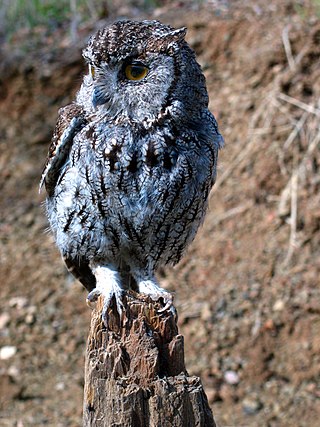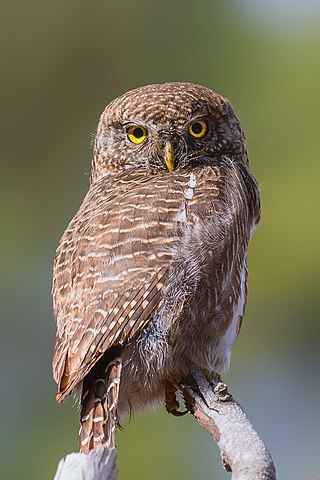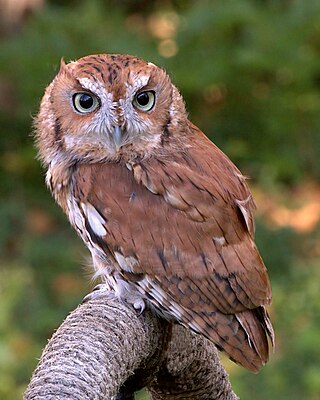
The northern saw-whet owl is a species of small owl in the family Strigidae. The species is native to North America. Saw-whet owls of the genus Aegolius are some of the smallest owl species in North America. They can be found in dense thickets, often at eye level, although they can also be found some 20 ft (6.1 m) up. Saw-whets are often in danger of being preyed upon by larger birds of prey. The northern saw-whet owl is a migratory bird without any strict pattern.

The eastern screech owl or eastern screech-owl, is a small owl that is relatively common in Eastern North America, from Mexico to Canada. This species resides in most types of woodland habitats across its range, and is relatively adaptable to urban and developed areas compared to other owls. Although it often lives in close proximity to humans, the eastern screech owl frequently avoids detection due to its strictly nocturnal habits.

The western screech owl is a small owl native to North and Central America, closely related to the eastern screech owl. The scientific name commemorates the American naturalist Robert Kennicott.

The Eurasian scops owl, also known as the European scops owl or just scops owl, is a small owl in the typical owl family Strigidae. Its breeding range extends from southern Europe eastwards to southern Siberia and the western Himalayas. It is migratory, wintering in Africa south of the Sahara.

The collared scops owl is an owl which is a resident breeder in south Asia from northern Pakistan, northern India, Nepal, Bangladesh, the Himalayas east to south China, and Taiwan. It is partially migratory, with some birds wintering in India, Sri Lanka and Malaysia. This species was formerly considered to be included within what is now separated as the Indian scops owl.

Scops owls are typical owls in family Strigidae belonging to the genus Otus and are restricted to the Old World. Otus is the largest genus of owls with 59 species. Scops owls are colored in various brownish hues, sometimes with a lighter underside and/or face, which helps to camouflage them against the bark of trees. Some are polymorphic, occurring in a greyish- and a reddish-brown morph. They are small and agile, with both sexes being compact in size and shape. Female scops owls are usually larger than males.

The red-cockaded woodpecker is a woodpecker endemic to the southeastern United States. It is a federally endangered species under the Endangered Species Act of 1973.

The Japanese scops-owl is a small owl species in the family Strigidae, or true owl family. It is a member of the genus Otus, the scops owl genus. It is resident to Japan, China, Korea, and Russia.

The Philippine scops owl is a common owl, endemic to the Philippines, belonging to the family of the typical owls Strigidae. Other common names include "Otus Whitehead", "Whitehead scops owl" and "Luzon lowland scops owl". Everett's scops owl and Negros scops owls were formerly considered conspecific but are now classified as separate species.

The elf owl is a small grayish-brown owl about the size of a sparrow found in the Southwestern United States, central Mexico, and the Baja California peninsula. It has pale yellow eyes highlighted by thin white "eyebrows" and a gray bill with a horn-colored tip. The elf owl frequently inhabits woodpecker holes in saguaro cacti; it also nests in natural tree cavities. It is nocturnal and feeds primarily on insects.

The Puerto Rican owl or múcaro común, formerly known as the Puerto Rican screech owl, is a mid-sized "typical owl" in subfamily Striginae. It is endemic to the archipelago of Puerto Rico though it formerly also inhabited the Virgin Islands.

The pallid scops owl is a small scops owl ranging from the Middle East to west and central Asia, sometimes called the striated scops owl.

The Andaman scops owl is a species of the Strigidae family and is native to the Andaman Islands of India. It is a largely brown owl with white speckles and yellow eyes. The owl was first described in 1873 by British Ornithologist Allan Octavian Hume. The Andaman Scops Owl has no sightings outside of the Andaman Islands, therefore research on this bird is limited. This owl is not threatened, though an increase in deforestation on the islands has led to the population size slowly declining. It is a nocturnal owl that feeds at night and has a nesting season from February to April.

The Asian Barred Owlet also known as the Cuckoo owlet is a species of pygmy owl native to the forests and shrublands of mainland Southeast Asia to the foothills of the Himalayas of northern Pakistan. It is a smaller owl, measuring 22–25 cm (8.7–9.8 in) making it one of the larger pygmy owls. They are primarily insectivorous but will eat lizards, small rodents and birds as well.

Koepcke's screech owl is a species of owl in the family Strigidae. It is endemic to Peru.
The Palau scops owl or Palau owl is a species of owl in the family Strigidae. Palau scops owls are dark reddish-brown with small white dots scattered across their feathers. They are endemic to the Palau Islands in the western Pacific, where they are found in woodland and lagoon trees, ravines and mangrove swamps. Palau owls nest in hollows of trees, live in groups and are territorial.

The flammulated flycatcher is a species of bird in the family Tyrannidae. It was formerly placed in the monotypic genus Deltarhynchus but was moved to the genus Ramphotrigon based on genetic analysis. It is endemic to the dry deciduous forest, arid thorn forest, and scrubby woodland of Mexico’s Pacific coast. The flycatcher is an olive to gray-brown bird with a streaked, pale gray chest, white throat, black bill, dark gray feet, and dark brown wings. It is a skulking bird that typically remains hidden in the underbrush. It feeds by gleaning insects off of leaves and twigs that it spots from an exposed perch. The female lays approximately three eggs in a nest made in a shallow tree cavity.

Screech owls are typical owls (Strigidae) belonging to the genus Megascops with 22 living species. For most of the 20th century, this genus was merged with the Old World scops owls in Otus, but nowadays it is again considered separately based on a range of behavioral, biogeographical, morphological, and DNA sequence data.

The mountain pygmy owl is a small species of owl from the family Strigidae. They reside throughout southern Arizona, New Mexico and Mexico.

The Cyprus scops owl is a small owl endemic to Cyprus.
























